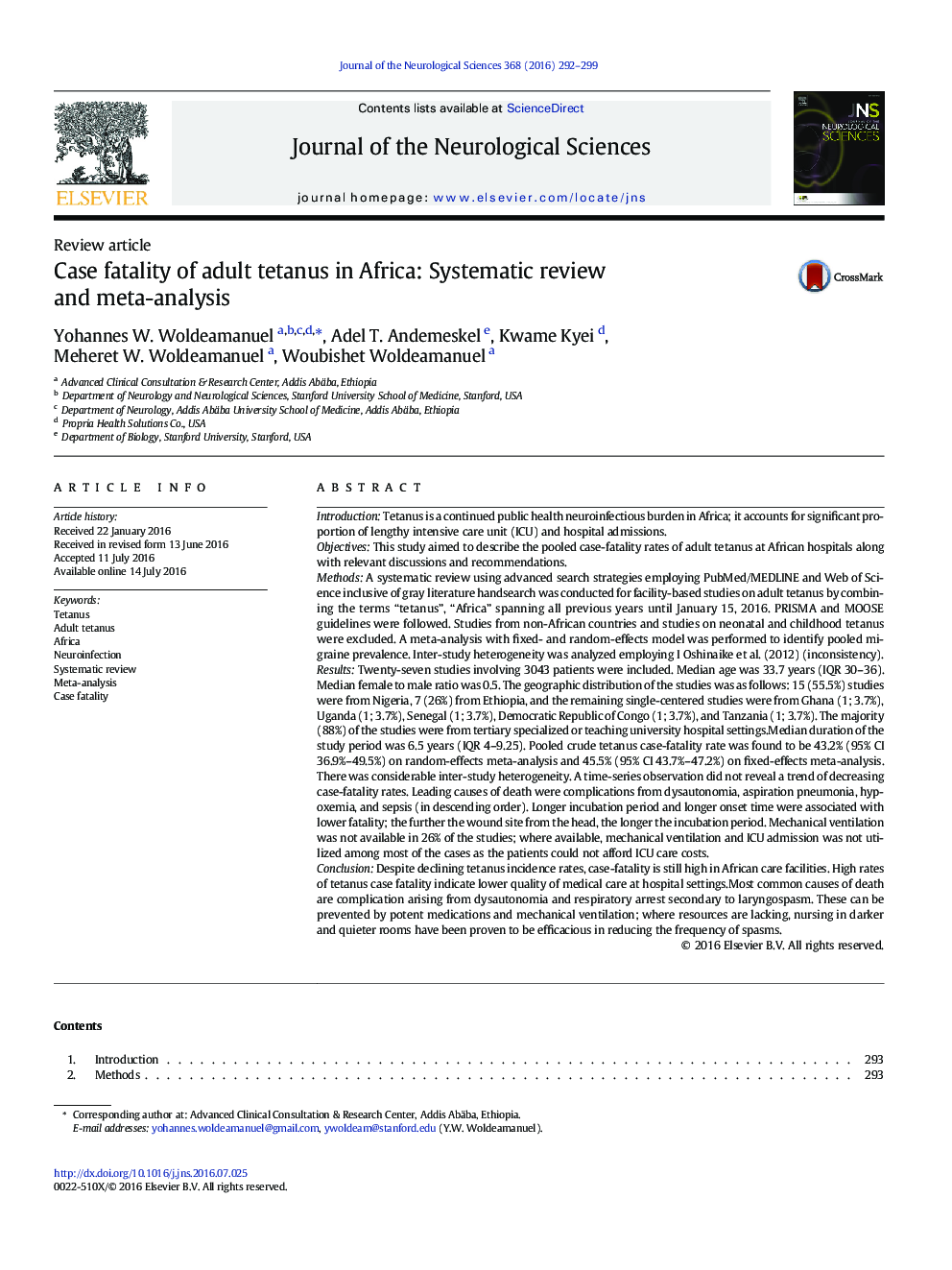| کد مقاله | کد نشریه | سال انتشار | مقاله انگلیسی | نسخه تمام متن |
|---|---|---|---|---|
| 1912946 | 1535094 | 2016 | 8 صفحه PDF | دانلود رایگان |
• Pooled tetanus crude case-fatality rate of 45% is high in African facilities, indicating lower care quality.
• Leading causes of death were dysautonomia, aspiration pneumonia, hypoxemia, and sepsis (in descending order).
• Medications, mechanical ventilation, nursing in darker and quieter rooms reduce spasms and mortality.
• Agrarian lifestyle and tropical hot, damp soil environment which is rich in organic matter are risk factors.
• Protective footwear and wound management are practicable and more cost-efficient strategies to reduce tetanus burden.
IntroductionTetanus is a continued public health neuroinfectious burden in Africa; it accounts for significant proportion of lengthy intensive care unit (ICU) and hospital admissions.ObjectivesThis study aimed to describe the pooled case-fatality rates of adult tetanus at African hospitals along with relevant discussions and recommendations.MethodsA systematic review using advanced search strategies employing PubMed/MEDLINE and Web of Science inclusive of gray literature handsearch was conducted for facility-based studies on adult tetanus by combining the terms “tetanus”, “Africa” spanning all previous years until January 15, 2016. PRISMA and MOOSE guidelines were followed. Studies from non-African countries and studies on neonatal and childhood tetanus were excluded. A meta-analysis with fixed- and random-effects model was performed to identify pooled migraine prevalence. Inter-study heterogeneity was analyzed employing I Oshinaike et al. (2012) (inconsistency).ResultsTwenty-seven studies involving 3043 patients were included. Median age was 33.7 years (IQR 30–36). Median female to male ratio was 0.5. The geographic distribution of the studies was as follows: 15 (55.5%) studies were from Nigeria, 7 (26%) from Ethiopia, and the remaining single-centered studies were from Ghana (1; 3.7%), Uganda (1; 3.7%), Senegal (1; 3.7%), Democratic Republic of Congo (1; 3.7%), and Tanzania (1; 3.7%). The majority (88%) of the studies were from tertiary specialized or teaching university hospital settings.Median duration of the study period was 6.5 years (IQR 4–9.25). Pooled crude tetanus case-fatality rate was found to be 43.2% (95% CI 36.9%–49.5%) on random-effects meta-analysis and 45.5% (95% CI 43.7%–47.2%) on fixed-effects meta-analysis. There was considerable inter-study heterogeneity. A time-series observation did not reveal a trend of decreasing case-fatality rates. Leading causes of death were complications from dysautonomia, aspiration pneumonia, hypoxemia, and sepsis (in descending order). Longer incubation period and longer onset time were associated with lower fatality; the further the wound site from the head, the longer the incubation period. Mechanical ventilation was not available in 26% of the studies; where available, mechanical ventilation and ICU admission was not utilized among most of the cases as the patients could not afford ICU care costs.ConclusionDespite declining tetanus incidence rates, case-fatality is still high in African care facilities. High rates of tetanus case fatality indicate lower quality of medical care at hospital settings.Most common causes of death are complication arising from dysautonomia and respiratory arrest secondary to laryngospasm. These can be prevented by potent medications and mechanical ventilation; where resources are lacking, nursing in darker and quieter rooms have been proven to be efficacious in reducing the frequency of spasms.
Journal: Journal of the Neurological Sciences - Volume 368, 15 September 2016, Pages 292–299
